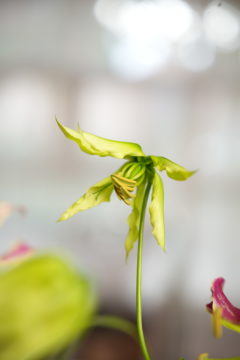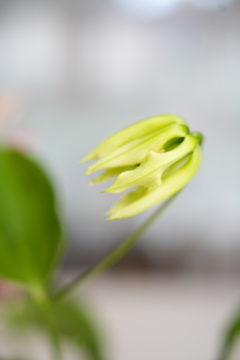Blog
Everything You Need To Know About The Gloriosa Lily

The gloriosa lily, also known as a flame lily or glory lily, is an eye-catching plant that belongs to the Colchicaceae family, which also includes sandersonia and crocus. It is native to tropical and southern Africa and Asia, and it is known for its strikingly beautiful flowers. The plant is highly valued in the cut flower industry and is often used for its vivid colours and unique shape.
One of the distinctive features of the gloriosa lily is the position of its stamen, which ends up on the outside of the flower. This creates a striking visual effect, with the vibrant yellow-orange stamen contrasting against the bold red or yellow petals.

Some gloriosa lily facts:
- It is the national flower of Zimbabwe
- It can grow up to two meters tall
- It is a climbing plant and it uses tendrils to climb up other plants or structures
- The flower petals of the gloriosa lily are the original reflexed flower
Origin of Gloriosa Lily
The gloriosa lily is believed to have originated in tropical and southern Africa and Asia. The plant was first introduced to Europe in the 18th century, and it quickly became popular due to its unique and stunning flowers. Today, the plant is widely cultivated in many countries, including India, South Africa, and the United States, and is even grown in Melbourne.
The gloriosa lily is a relatively rare plant and is not widely available in many parts of the world. However, the plant can be cultivated in greenhouses and other controlled environments, which makes it possible to grow it in many different climates.

Cultural Significance of Gloriosa Lily
The gloriosa lily has a rich cultural and symbolic significance across many different cultures and religions. For example, in Hinduism, the gloriosa lily is associated with the goddess Kali and is believed to have medicinal properties. In Africa, the gloriosa lily is sometimes used in traditional medicine to treat various ailments. In Western culture, the gloriosa lily is often associated with the concepts of pride and ambition, as well as with the idea of glory and honour.
Use of Gloriosa Lily
The gloriosa lily is primarily used in the cut flower industry and is highly valued for its beautiful flowers. The flowers come in various shades of red, orange and yellow, and they have a unique shape that adds a touch of elegance to any floral arrangement. The plant is also used in traditional medicine in some cultures, and it is believed to have antipyretic, analgesic and anti-inflammatory properties.
Caring for Gloriosa Lily
Gloriosa lilies are a popular choice for cut flower arrangements due to their unique shape and vivid colours. However, like all cut flowers, they require proper care to ensure they stay fresh and beautiful for as long as possible. Here are some tips on how to care for gloriosa lilies as cut flowers:
- When cutting the stems of gloriosa lilies, use a sharp, clean knife or scissors to avoid crushing the stem. Cut the stem at an angle to maximise the surface area that can absorb water.
- Remove any leaves that may fall below the water level to prevent bacteria from forming in the water.
- Fill a vase with clean, fresh water and add floral preservative to the water to keep the flowers fresh. Change the water every two days and re-cut the stems to keep them hydrated.
- Gloriosa lilies are sensitive to heat and direct sunlight, so it’s best to store them in a cool, shaded area. Avoid placing them near fruits or vegetables, which emit ethylene gas that can cause the flowers to wilt faster.
- Gloriosa lilies are delicate flowers, so handle them gently to avoid damaging the petals or breaking the stem. The tendrils of the gloriosa lily are also delicate and may need to be delicately separated from other tendrils and other parts of the stems to avoid tangling or knotting.
Not sure where to purchase gloriosa lilies? The Gloriosa Nursery is a small, family-run cut flower nursery in beautiful Emerald which is in the Dandenong Ranges. They specialise in growing gloriosa rothschildiana and sweet peas, as well as many other varieties. Gloriosa is picked from early November until late April.



